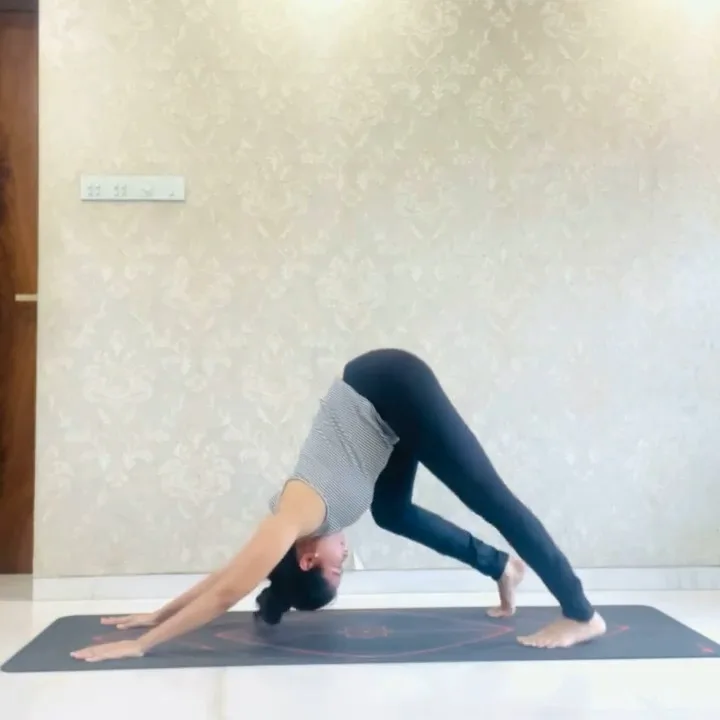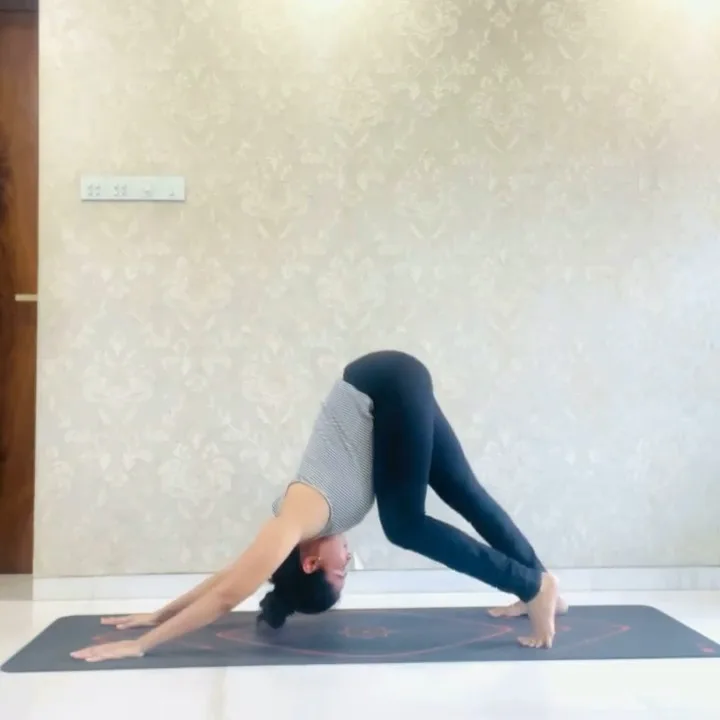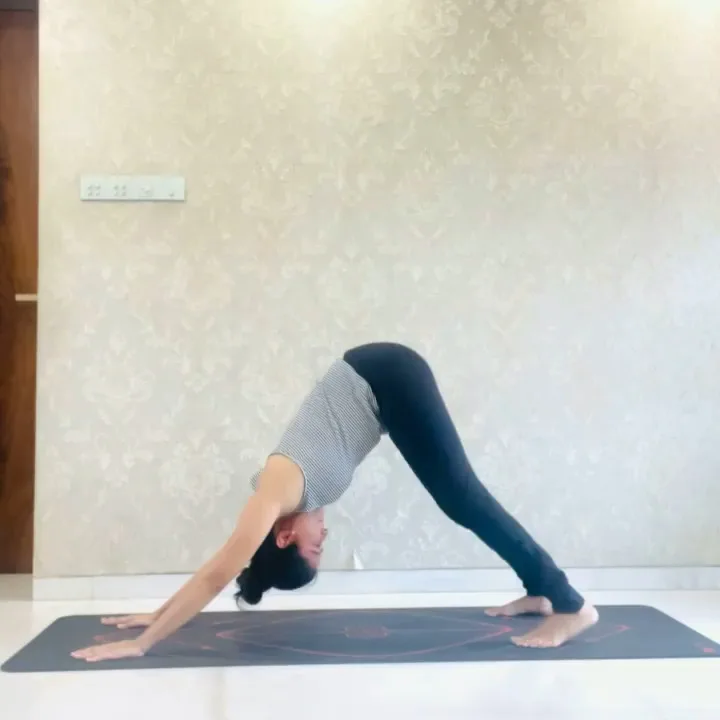Dynamic Downward Dog Pose is a variation of the traditional yoga pose Downward Dog (Adho Mukha Svanasana), it stretches the legs, hamstrings, calves, and ankles.
Benefits of Dynamic Downward Dog Pose
Dynamic Downward Dog Pose offers various physical and mental benefits, which are giving below:
Physical Benefits:
- Strengthens the upper body: The pose engages and strengthens the arms, shoulders, and upper back muscles.
- Stretches the hamstrings and calves: The alternating leg movements in the pose provide a gentle stretch to the hamstrings and calves, improving flexibility.
- Lengthens the spine: The elongation of the spine in the pose helps improve posture and release tension in the back.
- Opens the chest and shoulders: The pose expands the chest, stretches the chest muscles, and helps counteract rounded shoulders.
- Stimulates circulation: The inverted position in Dynamic Downward Dog Pose increases blood flow to the brain and upper body, promoting circulation.
- Enhances digestion: The gentle compression of the abdomen in the pose aids digestion and stimulates the digestive organs.
Mental Benefits:
- Energizing and invigorating: This pose can help increase energy levels and create a sense of vitality.
- Calms the mind: The mindful movement and focus on breath during the pose can help reduce stress, anxiety, and promote relaxation.
- Improves concentration: The coordination of movement and breath in the pose enhances mental focus and concentration.
- Boosts mood: The release of tension and the flow of energy in the body can contribute to an uplifted mood and sense of well-being.
- Promotes mindfulness: Practicing Dynamic Downward Dog Pose encourages present-moment awareness, cultivating a state of mindfulness.
Dynamic Downward Dog Pose Practice Guide


It involves fluid movements and transitions that add an element of dynamic stretching and engagement to the pose. Instead of holding the static position, Dynamic Downward Dog Pose incorporates movements like bending and straightening the legs alternately, resembling a walking motion while in the pose.
These dynamic movements help to further engage and stretch the muscles of the legs, hamstrings, calves, and ankles while maintaining the foundational alignment of Downward Dog Pose. Dynamic Downward Dog Pose is often used as a warm-up or active stretch in yoga sequences, providing a combination of strength, flexibility, and mindful movement.
Step-by-step Instructions
- Begin by assuming the Downward Dog Pose (Adho Mukha Svanasana). Initiate core activation by pulling your belly button towards the spine while on your hands and knees.
- Apply firm pressure on your hands and feet to lift your knees off the ground, forming an inverted ‘V’ shape.
- Keep your knees slightly bent while directing your heels towards the floor, extending the back of your legs.
- Strive for a straight line from your hands to hips, engaging your core by pulling your belly button towards the spine and drawing your lower ribs inward.
- Bend your left knee while straightening your right leg and pressing your right heel into the ground to stretch the hamstring, calf, and ankle. Alternate sides, mimicking a walking motion with your feet.
- A common error in this pose is rounding the lower back instead of maintaining a straight spine. To correct this, especially if your hamstrings are tight, deeply bend your knees and aim to slightly tilt the coccyx towards the ceiling.
Common Mistakes
In Dynamic Downward Dog Pose, there are a few common mistakes that practitioners may make. Developing body awareness, focusing on proper alignment, and listening to the body’s feedback are key in achieving a safe and effective the pose.
1. Rounded lower back
One common mistake is having a rounded lower back instead of maintaining a straight spine. This often happens when the hamstrings (back of the thighs) are tight. A rounded lower back reduces the effectiveness of the stretch and can strain the back muscles. To correct this, it is important to engage the core muscles and focus on lengthening the spine, while also deepening the bend in the knees and tilting the coccyx (tailbone) slightly upward.
2. Lack of core activation
Neglecting to activate the core is another mistake in this pose. When the core muscles are not engaged, it can lead to a collapsed or sagging posture, placing unnecessary strain on the shoulders and wrists. Pulling the belly button towards the spine helps stabilize the torso and maintain proper alignment throughout the pose.
3. Overarching the neck
Some individuals tend to let the neck drop and the head hang heavily in Dynamic Downward Dog Pose. This can strain the neck and cause discomfort. It is important to keep the neck in line with the spine and maintain a neutral position to avoid unnecessary strain.
4. Insufficient leg engagement
Allowing the legs to become passive or floppy in the pose can lead to a lack of stability and reduced effectiveness of the stretch. It is crucial to actively engage the leg muscles, particularly the quadriceps, to support the posture and optimize the benefits of the pose.
5. Incorrect hand and foot placement
Placing the hands too far forward or the feet too wide apart can compromise the stability and alignment in the pose. The hands should be shoulder-width apart and the feet hip-width apart for optimal balance and support.
Modifications and Variations
The modifications and variations aim to adapt the pose to individual needs, provide support, and enable practitioners to safely explore and benefit from Dynamic Downward Dog Pose. However, the modifications and variations of this yoga asana are explained below:
1. Modified Knee Bend
If you have tight hamstrings or limited flexibility, you can slightly bend the knees in the pose. This change relieves tension on the hamstrings and allows for a more accessible stretch at the back of the legs. To do this, maintain the same alignment as in the traditional pose, but keep a gentle bend in the knees while focusing on lengthening the spine and engaging the core.
2. Wall Support
Practicing Dynamic Downward Dog Pose with the support of a wall can be helpful for beginners or those with limited upper body strength. Stand facing a wall and place your hands on the wall at shoulder height, then step back and walk your feet away from the wall while maintaining the alignment of the pose. The wall provides support and stability, making it easier to hold the pose and work on proper alignment.
3. Puppy Pose Variation
This variation is useful for individuals with limited shoulder mobility or discomfort. Begin in a kneeling posture, with your hands and forearms on the ground in front of you, stretching them forward while maintaining your hips above your knees. Lower your forehead towards the mat, allowing the chest to sink towards the floor. This variation provides a gentle stretch for the shoulders and spine while reducing weight-bearing on the upper body.
4. Downward Dog with Blocks
Placing blocks under the hands can assist in achieving proper alignment and reduce strain on the wrists. Position the blocks at the desired height and distance, allowing the hands to rest comfortably on them. This modification helps individuals with wrist sensitivity or limited flexibility in the wrists to maintain stability and ease in the pose.
5. One-Legged Downward Dog
This variation adds an extra challenge to the pose and enhances core and leg strength. From the traditional pose, lift one leg off the ground while maintaining a straight line from hands to hips. This variation increases balance, strengthens the standing leg, and provides a deeper stretch for the lifted leg.
Counterposes
Counterposes are poses that are typically practiced after a particular pose to balance the body, release tension, and restore equilibrium.
The following counterposes can be practiced individually or in combination, depending on your needs and preferences. They offer a counterbalance to the physical and energetic effects of Dynamic Downward Dog Pose, helping to restore the body to a state of balance and prepare for subsequent poses or relaxation.
- Child’s Pose (Balasana): Child’s Pose is a gentle resting pose that provides a deep stretch for the lower back, hips, and thighs. It promotes relaxation, releases tension, and allows the body to recover after the active engagement of Dynamic Downward Dog Pose. Kneel on the floor, bring your buttocks back towards your heels, and rest your forehead on the mat while extending your arms forward or alongside your body.
- Standing Forward Fold (Uttanasana): Standing Forward Fold is a forward bending pose that stretches the hamstrings, calves, and back muscles. It can be an effective counterpose to release any residual tension in the posterior chain after Dynamic Downward Dog Pose. Stand with your feet hip-width apart, hinge at the hips, and fold forward, allowing your upper body to relax towards your legs.
- Cobra Pose (Bhujangasana): Cobra Pose is a gentle backbend that helps counteract the forward bending of Dynamic Downward Dog Pose and stretches the front body, including the chest and abdominal muscles. Lie on your stomach, place your hands near your shoulders, and gently lift your chest off the ground while keeping your pelvis and legs grounded.
- Standing Mountain Pose (Tadasana): Mountain Pose is a foundational standing pose that helps bring balance and stability to the body. It encourages proper alignment, improves posture, and provides a moment of grounding and centering. Stand tall with your feet hip-width apart, align your head, shoulders, and hips, and distribute your weight evenly through your feet.
Preparatory poses
Preparatory poses are poses that help warm up and prepare the body for a specific pose or a more challenging sequence.
Include following preparatory poses in your practice helps gradually warm up the body, increase flexibility, and prepare the relevant muscle groups for the specific demands of Dynamic Downward Dog Pose. Remember to move mindfully, honor your body’s limitations, and modify the poses as needed.
- Cat-Cow Pose (Marjaryasana-Bitilasana): Cat-Cow Pose is a gentle flowing sequence that warms up the spine and stretches the back muscles. Start on your hands and knees, arch your back up like a cat (Cat Pose), and then drop your belly down and lift your chest (Cow Pose). Repeat this fluid movement several times to loosen the spine and awaken the body.
- Thread the Needle Pose (Parsva Balasana): Thread the Needle Pose is a shoulder and upper back opener that prepares the shoulders for weight-bearing in Dynamic Downward Dog Pose. Begin in a tabletop position, slide your right arm underneath your left arm, lowering your right shoulder and resting your right cheek on the mat. Hold for a few breaths and repeat on the other side.
- Downward Dog with Bent Knees: Practicing Downward Dog with bent knees is an excellent preparatory pose for Dynamic Downward Dog Pose. It helps warm up the hamstrings and calves while also allowing for a deeper opening in the shoulders and upper back. Start in a tabletop position, then lift your hips up and back while keeping your knees bent. Focus on lengthening the spine and extending through the arms.
- Standing Forward Fold (Uttanasana): Standing Forward Fold gently stretches the hamstrings and back of the legs, preparing them for the lengthening and stretching required in Dynamic Downward Dog Pose. Stand with your feet hip-width apart, hinge at the hips, and fold forward, allowing your upper body to relax towards your legs. Bend your knees as much as needed to find a comfortable stretch.
- Plank Pose (Phalakasana): Plank Pose builds core strength and prepares the body for the weight-bearing and stability required in Dynamic Downward Dog Pose. Start in a high push-up position with your wrists directly below your shoulders. Engage your core, lengthen your spine, and hold the position for a few breaths, focusing on proper alignment and stability.
Follow-up poses
Follow-up poses are poses that can be practiced after Dynamic Downward Dog Pose to further deepen the practice, explore related movements, or provide a balanced sequence.
Including following follow-up poses after Dynamic Downward Dog Pose helps create a well-rounded practice that balances strength, flexibility, and relaxation. Remember to listen to your body, modify the asanas as needed, and honor your own energy levels and limitations.
- Warrior I (Virabhadrasana I): Warrior I is a standing pose that strengthens the legs, opens the chest, and improves balance. From Downward Dog, step one foot forward between your hands, rotate the back foot at a 45-degree angle, and lift your torso up, reaching your arms overhead. This pose adds strength and stability to the practice while stretching the hip flexors.
- Upward Dog (Urdhva Mukha Svanasana): Upward Dog is an invigorating backbend that opens the chest, stretches the front body, and strengthens the arms and wrists. From Downward Dog, shift forward into a plank position and lower your body down, keeping your legs active. Press into your hands, lift your chest, and roll your shoulders back. This pose complements the forward bending aspect of Downward Dog and provides a counter-stretch.
- Standing Forward Fold (Uttanasana): Returning to Standing Forward Fold after Downward Dog allows you to revisit the hamstring and calf stretches while focusing on relaxation and surrender. Stand with your feet hip-width apart, hinge at the hips, and fold forward, allowing your upper body to relax towards your legs. You can hold onto your elbows or sway gently from side to side.
- Child’s Pose (Balasana): Child’s Pose is a resting pose that promotes relaxation, releases tension in the back, and provides a gentle stretch to the hips and thighs. From Downward Dog, lower your knees to the mat, sit back on your heels, and fold your torso forward, resting your forehead on the mat. Extend your arms forward or alongside your body. Child’s Pose helps to calm the mind and bring a sense of grounding.
- Savasana (Corpse Pose): Savasana is the final relaxation pose that allows for integration and restoration. After your practice, lie down on your back, legs extended, arms relaxed by your sides, palms facing up. Close your eyes and focus on releasing any tension in the body, allowing yourself to fully relax and absorb the benefits of your practice.
Precautions and Contraindications of Dynamic Downward Dog Pose
Consider precautions and contraindications before practicing Dynamic Downward Dog Pose, it help ensure safety and prevent potential injuries or adverse effects.
1. Wrist or shoulder injuries
Individuals with wrist or shoulder injuries or conditions like carpal tunnel syndrome, tendonitis, or rotator cuff injuries should approach the pose with caution or avoid it altogether. The weight-bearing nature of the pose may exacerbate existing issues or put excessive strain on the affected areas. Modifications, such as using props or practicing alternative poses, should be considered.
2. High blood pressure or cardiovascular conditions
The inverted position of Dynamic Downward Dog Pose increases blood flow to the head and upper body. Individuals with high blood pressure, heart conditions, or glaucoma may need to modify the pose or avoid it altogether due to the potential for increased pressure in the head and eyes. It is essential to consult with a healthcare professional before attempting this pose if you have any of these conditions.
3. Pregnancy
Pregnant individuals should exercise caution while practicing Dynamic Downward Dog Pose. As the pose involves an inversion and abdominal compression, it is generally recommended to avoid full inversions during pregnancy. Modified variations or prenatal-specific poses should be explored instead. Consultation with a prenatal yoga instructor or healthcare provider is highly advised.
4. Lower back or neck injuries
Those with lower back or neck injuries should approach the pose with care. A rounded lower back or misalignment can strain these areas further. Modifications, such as bending the knees, reducing the depth of the pose, or practicing alternative poses that offer more support, may be suitable. It is advisable to consult with a healthcare professional or a qualified yoga instructor for personalized guidance.
5. Recent surgery or medical conditions
Individuals who have undergone recent surgery or have specific medical conditions should seek guidance from their healthcare provider before attempting Dynamic Downward Dog Pose. Certain conditions may require modifications, limitations, or avoidance of the pose altogether to ensure safe practice and prevent complications.
6. Individual limitations
Each person’s body is unique, and individual limitations or injuries should be considered. If you experience pain, discomfort, or any unusual sensations during the pose, it is important to listen to your body and modify or discontinue the pose as needed. Respect your body’s boundaries and work within your comfortable range of motion.















